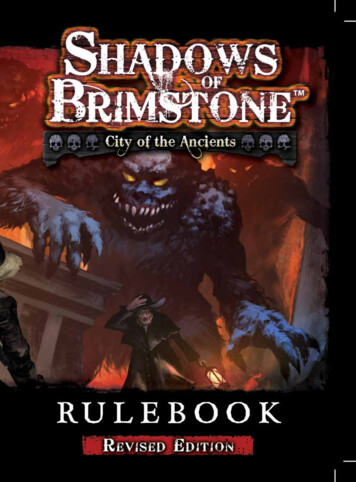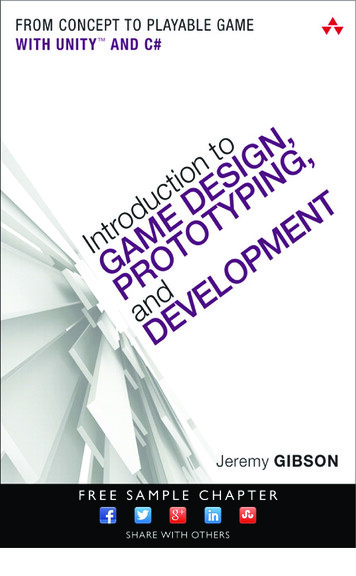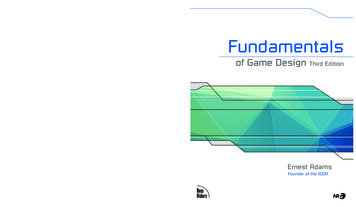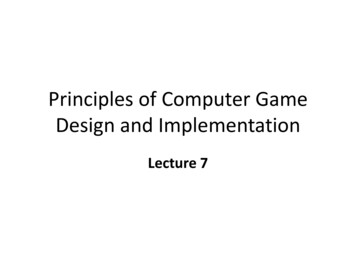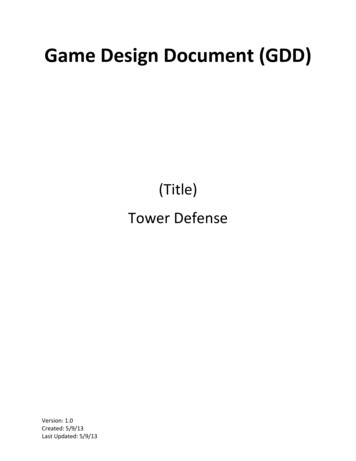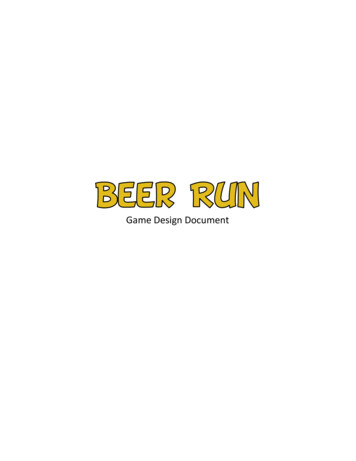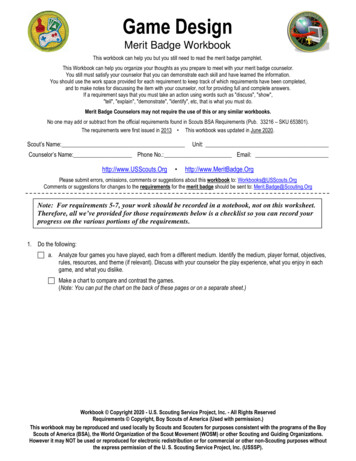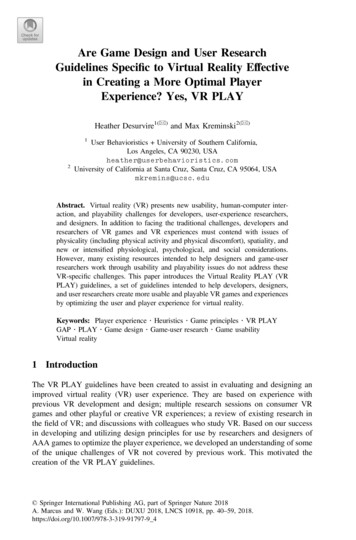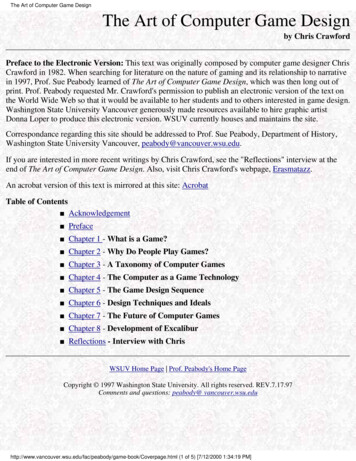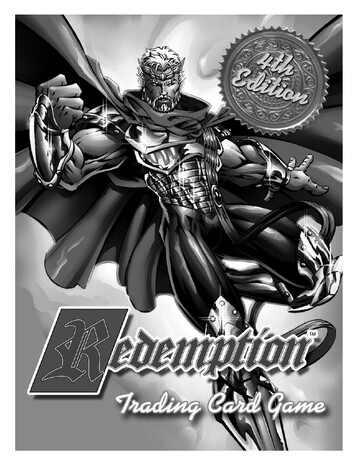
Transcription
IntroductionRedemption is a collectable trading card game ofbiblical adventure. Players use Heroes to rescue LostSouls, overcoming any Evil Characters who opposethem.On your turn you will use Heroes (cross icon cards)to make a rescue attempt. On your opponent’s turn,you will use your Evil Characters (dragon icon cards)to block your opponent’s rescue attempt.In Redemption you may custom build your owndeck. Designing a new deck allows you to continuallydiscover new strategies for victory. To build yourdeck, you may purchase additional card packs thatinclude common, uncommon, rare, or ultra rarecards.Game OverviewRescuesYour Hero rescues a Lost Soul if the Hero crossesthe Field of Battle to reach the Lost Soul in youropponent’s Land of Bondage. Sometimes a Hero isunblocked, but usually your Hero must defeat an EvilCharacter in the Field of Battle. The Evil Character isdefeated if one of these happens:2
Your Hero’s strength (*/) is greater than orequal to the blocking Evil Character’s toughness(/*), or The blocking Evil Character is removed frombattle (by being discarded, removed from thegame, withdrawn, underdecked, etc.)Your Hero is made stronger with good enhancements(Bible icon cards). Your opponent’s Evil Character ismade stronger with evil enhancements (skull iconcards).The brigade color of the enhancement mustmatch the brigade color of the character using theenhancement.When the last Evil Character(s) in battle is defeated,your opponent must surrender a Lost Soul fromhis Land of Bondage. Then that Lost Soul goes toyour Land of Redemption . The rescue attemptis successful, and the Lost Soul is now called aRedeemed Soul. However, if you do not defeat theblocking Evil Character(s), your rescue attempt fails.You are permitted one rescue attempt per turn.WinningYou keep score by the number of Redeemed Soulsfound in your Land of Redemption . The player withthe most Redeemed Souls wins. A game ends whenone player has rescued five (5) Lost Souls.Note to New PlayersThe two 50 card decks included with thisrulebook are ready to play. One player should3
use Deck I and the other player should useDeck J. We strongly recommend that you playa few games with these basic decks beforeadding cards.This quick start rulebook instructs new playersin the rules of the game using the I and Jstarter decks.Additional Redemption .php 4th Edition Expanded Rulebook that covers thegame in greater detail. The Redemption Exegetical Guide .php Sample Game is a complete scripted game usingthe cards found decks I and J. The Cactus Discussion Board is the place to askquestions and discuss the game. http://www.cactusgamedesign.com/message boards/forum/ Tournament Guide is your source to prepare forofficial Redemption tournaments. Redemption Online Official Tournament isyour chance to play games with other playersanywhere in the world for free. http://www.cactusgamedesign.com/message boards/redemption-online-official-tournament/4
Anatomy of a CardNote: The card above has abilities (numbers) of10/10. The first number is the strength (assaultingpower) of Peter. The second number is thetoughness (resistance power) of Peter.Beginning a GamePreparationsBegin with a legal deck. (Decks I and J are legal).5
Start by thoroughly shuffling your deck. Youropponent(s) may also shuffle your deck. Aftercompleting your shuffle, cut your opponent’s deckby leaving at least five (5) cards in the smaller pile.When more than two people are playing, each playerwill cut the deck of the player to his left.Each player draws eight (8) cards to form a startinghand. Rules for drawing cards: Cards are always drawn from the top of theplayer’s own deck and placed in the player’shand. Each time you draw a Lost Soul at any time inthe game, it is immediately placed in your Landof Bondage and replaced by drawing anothercard. You may not look at cards in any deck or discardpile (other than the top card of the discard pile)unless a special ability on a card allows a playerto search a deck or discard pile. The deck isalways reshuffled when this occurs.First TurnThe player who has the most Lost Soul cards in hisLand of Bondage decides who will take the first turn.If two or more players draw the same number of LostSoul cards, roll a die (or use some other mutuallyagreeable method) to determine who will choose theplayer to take the first turn. The player selected togo first will begin his first turn (see Expanded TurnDescription p. 10). In two Player games, the player6
who goes first does not draw 3 cards to start his firstturn. The person to the player’s left takes the nextturn. A round is completed when each player finishesone turn.Player’s Card Arrangement7
Turn SummaryThe following phases are performed each turn, evenif nothing is actively done on a particular phase. Aresponse is allowed at the end of every separatephase.Draw Phase – You draw three (3) cards andadd them to your hand. Lost Souls are placedin territory. For each Lost Soul you draw, drawanother card.Preparation Phase – You may place anynumber of characters (cross or dragon icon)into your territory.Battle Phase – Follow these steps in order:a. You may begin a rescue attempt or battlechallenge by placing one Hero into the Fieldof Battle. When the Hero enters battle,activate its special ability (its owner readsthe card and follows the directions). If youmake a rescue attempt or battle challenge,go to step b. Otherwise, skip to the DiscardPhase.b. Your opponent may block your Hero byplacing one Evil Character into the Fieldof Battle. When the Evil Character entersbattle, activate its special ability (its ownerreads the card and follows the directions).8
c. Check for initiative (see DetermineInitiative p. 15). The player with initiativemay play an enhancement (or pass ifallowed). Repeat this step as necessary.d. Resolve the rescue attempt or battlechallenge (battle resolution). Note thatDominant cards cannot be played here.1 End of battle (no more enhancementscan be played)2 Discard characters in battle that aredefeated3 if the Evil Character is defeated,transfer a Lost Soul (if there is one)from the blocker’s Land of Bondage tothe rescuer’s Land of Redemption4 Return surviving characters toterritory; discard enhancements in theField of BattleDiscard Phase – Before ending your turn youmust decrease your hand to eight (8) cards orless. You may place characters from your handinto your territory. If you still have more thaneight (8) cards in your hand, then discard cardsfrom your hand face up onto your discard pileuntil you have eight (8) or fewer cards in hand.Then announce that you are finished.9
This ends your turn. Play now passes to theleft.Expanded Turn DescriptionDraw PhaseIn the first round of a two player game, the firstplayer skips the Draw Phase. In the first round ofa multi-player game, each player skips the DrawPhase. Each turn after this, you draw three (3) cards.If you draw a Lost Soul, instead of placing it in yourhand, place it in your Land of Bondage and draw areplacement card.Preparation PhaseDuring the Preparation Phase, you place cardsonto certain parts of the table. (See Player’s CardArrangement p.7).CharactersYou may place any number of characters (Heroesor Evil Characters) into your territory. Charactersput into play remain in play for the rest of the gameunless defeated in battle or removed from play by aspecial ability.Battle PhaseIf there is a Lost Soul in an opponent’s Land ofBondage, you may make a rescue attempt. If there10
is no Lost Soul in an opponent’s Land of Bondage,you may make a battle challenge or skip to yourDiscard Phase.Present HeroYou begin a rescue attempt or battle challenge byplacing one Hero in the Field of Battle. The Hero canbe played from your hand or your territory. SomeHeroes have a special ability printed in the text boxabove the Scripture. This special ability does notbecome active until the Hero enters battle. Whenthe Hero enters battle, the special ability activates.The instructions on the card must be applied at thatmoment. If the special ability includes the word“may,” you can choose to activate the special abilityor skip it for that battle. Once the Hero has enteredbattle and special ability completed, he has begunthe battle. At this point, declare your intentions tomake a rescue attempt or battle challenge.Example – Using special abilitiesYou put the white brigade Hero Boaz into the Fieldof Battle. His special ability reads, “You may draw1. May band to a Ruth Hero.” This should be donebefore you or your opponent play any other cards.Even if your opponent is not going to block yourrescue attempt or battle challenge, once you placeBoaz into battle, you may draw one card from yourdeck. You may also add a second Hero to the Field ofBattle if that Hero has a reference from the book ofRuth.11
Example – Optional special abilitiesYou make a rescue attempt with Jephthah, a goldbrigade Hero with the special ability, “Once pergame, you may discard the top card of your deck todiscard up to 2 Evil Characters.” Since the specialability includes the word “may,” you can choose tocomplete this instruction now or complete it duringa later turn when Jephthah enters battle. However,you must decide at this moment. You may not usethat special ability later in the battle. If you chooseto do it now, you discard the top card from your deckand discard 1 or 2 Evil Characters. Also, since youare permitted to use Jephthah in this way only onceper game, you should remember not to use thatability again in that game.Example – Mandatory special abilitiesThe Hero John has the special ability, “Negate EvilCharacters.” Since the special ability does not includethe word “may,” you do not choose if this takeseffect. Once you put John into battle, the specialability on any evil character that enters battle thatturn is stopped from activating.BlockYour opponent must decide whether to block yourrescue attempt or battle challenge. If your opponentchooses to block, he should place one Evil Characterinto the Field of Battle to fight your Hero. This EvilCharacter can come from his territory or his hand.Just like Heroes, some Evil Characters have a special12
ability printed in the box above the Scripture. Thesespecial abilities work the same way they do forHeroes.If your opponent does not block your rescue attemptor otherwise stop your Hero, then your Hero crossesthe Battle unchallenged and rescues one Lost Soul ifone is available.If your opponent does not block your battlechallenge, then your Hero must withdraw from theField of Battle back to your territory without playingany enhancements.Example – Optional special abilitiesYour opponent blocks with Unclean Spirit whohas the special ability, “May band to a human EvilCharacter.” Since the special ability includes theword “may,” your opponent has the choice (assumingthere is a human Evil Character in either player’sterritory or your opponent’s hand) to band to ahuman Evil Character or not to band. However, youropponent must decide at this moment. He may notuse Unclean Spirit’s special ability later in thebattle.Example – Mandatory special abilitiesThe Evil Character Mocking Soldiers has the specialability, “Underdeck a random card from opponent’shand.” When your opponent puts Mocking Soldiersinto the Field of Battle to block your Hero, he must13
take a random card from your hand and place it atthe bottom of your deck. This is not a choice becausethe special ability does not include the word “may.”Banding special abilitiesEven though you are permitted multiple Heroesand Evil Characters in your territory, you are onlypermitted one Hero in battle unless you play a cardthat allows you to band (add) an additional Hero tothe battle. Your opponent is only permitted one EvilCharacter in battle unless he plays a card that allowshim to band (add) an Evil Character to battle.Example - BandingYou put the white brigade 6/5 Hero Boaz into theField of Battle. His special ability reads, “You maydraw 1. May band to a Ruth Hero.” You draw acard from your deck. Then you check the Heroesin your hand and the Field of Play (both yours andyou opponent’s territory) to see if any Heroes havea Scripture reference from the book of Ruth. Youhave Naomi, a white brigade 4/5 Hero in yourhand. Her special ability reads, “May band to aRuth Hero.” You add Naomi to the battle. Youactivate Naomi’s special ability and see that youropponent has the white brigade 4/3 Hero Ruth inyour territory. Using Naomi’s special ability youadd Ruth to the battle. Ruth’s special ability reads,“Negate Evil Characters.” You now have three whitebrigade Heroes banded together in battle with theirabilities added together for a total of 14/13. If your14
opponent chooses to block these three Heroes, thespecial abilities on your opponent’s Evil Characterswill not work because they are being negated byRuth.Note: Your opponent is not required to block yourrescue attempt if he does not see a chance to winthe battle based on his available evil characters,enhancements and dominant cards.Determine InitiativeIf you have a Hero(es) in the Field of Battle and youropponent has an Evil Character(s) in the Field ofBattle, you need to check for initiative. Your Hero(es)is in one of four possible situations (see SituationDescriptions p. 19): Losing the BattleEx:(Your Hero is at 6/7 Evil Character is at 8/8). Winning the BattleEx:(Your Hero is at 6/7. Evil Character is at 6/6). Mutual DestructionEx:(Your Hero is at 5/7. Evil Character is at 7/4). StalemateEx:(Your Hero is at 5/7. Evil Character is at 6/7).The player whose character(s) is losing after a cardhas been played has initiative. If the characters arein a mutual destruction situation or a stalemate,then the player who did not play the last card hasinitiative.15
If you have initiative, you may play an enhancement.The brigade color of the enhancement mustmatch the brigade color of the character using theenhancement. Multi-colored good enhancementsmay be used by any Hero, and multi-colored evilenhancements may be used by any Evil Character.You can only play (activate) enhancements oncharacters that are in the Field of Battle. (SeeExceptions to Enhancements Played in the Field ofBattle in the Advanced Rules on page 35.)The numerical abilities (*/*) on the enhancement arealways added to the abilities (*/*) of the characterupon which the enhancement is played.The special ability of the enhancement is carried outby the person who played the enhancement.Example – Number abilities(Assume you have the initiative to play all cards inthis example). You are making a rescue attemptwith Angel at Bethesda, a silver brigade Hero withabilities of 3/1. You play Overwhelming Presence,a silver brigade enhancement that adds 3/3 to Angelat Bethesda’s abilities by for a total of 6/4. Youthen play Angelic Guidance to increase the hero’sabilities by 1/6 for a total of 7/10.Example – Special abilities(Assume you have the initiative to play all cards inthis example). You are making a rescue attempt withPeter, a purple brigade Hero with abilities of 10/10.You play the purple brigade enhancement Fishers16
of Men with abilities (2/2), for a total of 12/12.Moreover, Fishers of Men has the special ability,“Reveal the top 3 cards of opponent’s deck (or top 9if used by a Disciple); put the revealed Lost Souls inopponent’s territory and underdeck the rest.” Fishersof Men is activated on Peter. The abilities (2/2)add to Peter’s and the special ability targets youropponent’s deck.Initiative TableIf yourcharacter is:This player hasinitiative:If the player withinitiative does not playan ehancement, then:LosingYouDo not pass initiative.Resolve battle.In a StalemateWhoever didnot play the lastcardPass initiative.In a MutualdestructionWhoever didnot play the lastcardPass initiative.WinningOpponentDo not pass initiative.Resolve battle.Playing Enhancements in BattleYou and your opponent play enhancements on yourown characters according to the rules for initiativeuntil the player who is losing either cannot playor chooses not to play any more enhancements.In mutual destruction or stalemate situations,players must either play an enhancement or pass.If there are three consecutive passes (i.e. you pass,17
opponent passes, you pass again), then resolve thebattle. (See Battle Resolution).NOTE: It is possible to play one or more cardsand keep initiative.Dominants Played During BattleYou and/or your opponent can play a dominant(s)(lamb or grim reaper icon) at any time duringthe game except while a special ability is beingcompleted or during Battle Resolution. Neither younor your opponent is required to wait for initiativeor turn to play a dominant. The special ability on adominant is instantaneous and nothing can negateits effect. Dominants are extremely useful in battle,though they may be played at other times.NOTE: Dominants do not negate otherdominants or the special abilities of other cards.When more than one dominant is played, thefirst dominant played on the playing surface isthe one that takes effect first.Example – Playing Dominants DuringBattleYou are making a rescue attempt with John, apurple brigade Hero with abilities of 5/5. Youropponent blocks with Saph, a black brigade EvilCharacter with abilities of 9/11. You hero is losing.You have initiative.Instead of playing an enhancement on John, you18
play Angel of the Lord, a dominant (lamb iconcard), that allows you to “Discard an Evil Character”.You discard Saph. Your opponent cannot stopthis using an enhancement. Your opponent alsocannot present a new Evil Character. John, who isnow unblocked, rescues a Lost Soul (unless youropponent plays Chistian Martyr (grim reaper iconcard) that allows him to “Discard a Hero.”).Situation DescriptionsLosing the BattleA Hero can be losing the battle by numbers or byremoval from the battle:Losing by NumbersYour Hero is losing by numbers if the Hero’stoughness (/*) is less than or equal to the EvilCharacter’s strength (*/) and the Evil Character hastoughness (/*) greater than your Hero’s strength(*/). You have initiative and can play any goodenhancement of matching brigade.Example – Losing by numbersYou are making a rescue attempt with John, apurple brigade Hero with abilities of 5/5. He is inbattle with Selfish Kinsmen, a brown brigade EvilCharacter with abilities of 5/7. John’s strength is 5while Selfish Kinsmen has toughness of 7. SelfishKinsmen is not being defeated. Selfish Kinsmen’s19
strength is 5 while John has toughness of 5. Johnis being defeated. Therefore, you have the initiativeto play a good enhancement on John to increase hisabilities. When your Hero is losing, you may not passinitiative to your opponent. You must play a card orthe battle is resolved.Losing by Removal (because of aSpecial Ability)A Hero is losing by removal if the last Hero in battleis being discarded, withdrawn, underdecked, orotherwise removed from battle by an opposingspecial ability. You have initiative, but you may onlyplay an enhancement that has a “negate” specialability.Example – Losing by special abilityYou are making a rescue attempt with Gideon, agold brigade Hero with abilities of 6/8. Your opponentblocks with the Evil Character Possessing Demon,an orange brigade Evil Character with abilities of3/4. Since Possessing Demon is losing, youropponent has initiative to play an evil enhancement.Your opponent plays Fiery Darts. Its special abilityreads, “Discard a Hero.” Your opponent targetsGideon for discard. This is causing Gideon tobe losing by removal. You have initiative, but youmay only play an enhancement that will “negate”Fiery Darts. Otherwise, your opponent will discardGideon, forcing you to place him on your discardpile. Samson’s Strength would be an excellent20
counter move for you in response to Fiery Dartsbecause it would negate and discard Fiery Darts.StalemateThe battle is currently a stalemate when neither theHero(es) nor the Evil Character(s) is being defeated.Example –You are making a rescue attempt with Naomi, awhite brigade Hero with abilities of 4/5. She is inbattle with Controlling Demon, a black and orangedual brigade Evil Character with abilities of 4/11.Naomi has strength of 4 compared to ControllingDemon who has a toughness of 11. ControllingDemon is not being defeated. ControllingDemon has strength of 4 compared to Naomiwho has a toughness of 5. This is a stalematebecause neither character is being defeated. Youhave initiative because your opponent played thelast card (Controlling Demon). You may play anenhancement or a dominant or, if you choose, youmay pass the initiative to your opponent.Mutual DestructionA mutual destruction situation exists when therescuing Hero(es) and the blocking Evil Character(s)are both being defeated. This can happen bynumbers or by a “remove all” special ability.21
Mutual Destruction by NumbersBoth characters in battle are being defeated becauseof numbers only. You have initiative and can playa good enhancement of matching brigade. If youchoose not to play a card, you must pass initiativeto your opponent. Your opponent may play anenhancement. If your opponent chooses not toplay a card, he must pass initiative back to you. Ifyour opponent passes initiative back to you, thenyou must play an enhancement or the Battle Phaseresolves.ExampleYou put James, a purple brigade Hero with abilitiesof 8/6, into the Field of Battle. Your opponent blockswith Foul Spirit, an orange brigade Evil Characterwith abilities of 6/7. Each character has enoughstrength to defeat the opposing character. Youhave initiative because this is a mutual destructionsituation and your opponent played the last card(Foul Spirit). If you choose, you may pass initiativeto your opponent in a mutual destruction situation.If your opponent passes initiative back to you, thenyou must play a card or the Battle Phase ends.Winning the BattleA Hero can be winning the battle by numbers or byremoval:22
Winning by NumbersThe Hero is winning the battle by numbers whentwo conditions are met. First, the total strength (*/)of the Hero(es) in battle is equal to or greater thanthe toughness (/*) of the blocking Evil Character(s).Second, the toughness (/*) of the Hero(es) isgreater than the total strength (*/) of the blockingEvil Character(s). Your opponent has initiative andcan play any evil enhancement of matching brigade.Example – Winning by numbersYou are rescuing with Gideon, a gold brigade Herowith abilities of 6/8. He is being blocked by Achan,a brown brigade Evil Character with abilities of 3/4.Gideon is winning because his strength of 6 isgreater than the 4 toughness of Achan, and becausethe 3 strength of Achan is less than the 8 toughnessof Gideon. Your opponent has the initiative to playthe first enhancement.NOTE: Your opponent cannot pass initiative toyou when his Evil Character is losing the battle.Your opponent must play a card or the battleresolves. (See Battle Resolution p. 24).Winning by Removal Because of aSpecial AbilityYour Hero is winning a battle by removal if aspecial ability removes the blocking Evil Characterfrom battle. Your opponent has initiative, but youropponent may only play an enhancement that has a23
“negate” ability.Example – Winning by special abilityYou are rescuing with Gideon, a gold brigadeHero with abilities of 6/8. Your opponent blockswith Ishbibenob, a black brigade Evil Characterwith abilities of 8/12. Gideon is losing. Therefore,it is your initiative, and you play Trumpets andTorches, a gold brigade enhancement with abilitiesof 3/0 and the special ability, “Discard an EvilCharacter.” You select Ishbibenob to discard. YourHero will win the battle, unless your opponent canplay an enhancement to negate Trumpets andTorches.Battle ResolutionAfter the last enhancement is played andplayers have passed, the battle ends andoutcome must be resolved. It is now tooa Dominant card this battle. The possibleare:Evil Character Winsboththe battlelate to playoutcomesYour opponent’s Evil Character wins if one of theseconditions is met: The Evil Character’s strength is greater thanor equal to the Hero’s toughness, and theHero’s strength is less than the Evil Character’stoughness. The Hero is discarded, and the EvilCharacter withdraws to the territory that it camefrom.24
All Heroes were removed from battle. Eachsurviving Evil Character is returned to hisowner’s territory.All enhancements played during the Battle Phase arediscarded to the owner’s discard pile.No Lost Soul is rescued.Hero WinsYour Hero wins if one of these conditions is met:The Hero’s strength is greater than or equal to theEvil Character’s toughness, and the Evil Character’sstrength is less than the Hero’s toughness. The EvilCharacter is discarded, and your Hero withdraws toyour territory. All blocking Evil Characters were removed frombattle. Surviving Heroes return to their owners’territories.All enhancements played during the Battle Phaseare discarded to the respective owner’s discard pile.The rescue attempt is successful, and your opponentmust select and surrender to you one available LostSoul from his Land of Bondage.Mutual DestructionThere are two possible scenarios for mutualdestruction:25
Mutual Destruction by NumbersThe battle ends in a mutual destruction by numbersif both the Hero(es) and the Evil Character(s) haveenough strength to defeat each other. In this caseboth the Hero(es) and the Evil Character(s) arediscarded. All enhancements played during the BattlePhase are discarded to each player’s respectivediscard pile. JUST AS CHRIST LAID DOWN HISLIFE TO REDEEM US, THE HERO IS WILLING TOLAY DOWN HIS LIFE TO RESCUE A LOST SOUL.Therefore, in a mutual destruction by the numbers,the rescue attempt is successful. Your opponentmust select and surrender to you one available LostSoul from his Land of Bondage. This is considered adefeat of the Evil Character because the Hero wasable to make a successful rescue even though theHero was discarded.Mutual Destruction by Mutual RemovalMutual destruction by mutual removal does notresult in a successful rescue.StalemateThe rescue attempt ends in a stalemate if neitherthe Hero(es) nor the Evil Character(s) have enoughstrength to defeat the other. Both the Hero(es)andthe Evil Character(s) withdraw to their respectiveterritories. All enhancements played during the BattlePhase are discarded. No Lost Soul is rescued. This isconsidered a defeat of the Hero since the Hero wasunable to make a successful rescue.26
Discard PhaseBefore ending your turn you must decrease yourhand to eight (8) cards or less. You may placecharacters from your hand into your territory. If youstill have more than eight (8) cards in your hand,then discard cards from your hand face up onto yourdiscard pile until you have eight (8) or fewer cards inhand. Then announce that you are finished.This ends your turn. Play now passes to the left.Winning the GameWhen one player has rescued 5 Lost Souls andhas placed these Redeemed Souls into his Land ofRedemption , that player wins the game. If a gamereaches a point where neither player can save 5Lost Souls, the game ends. The player with the mostRedeemed Souls wins the game.Glossary of TermsAbilities (numbers): Abilities are points ofoffensive strength (*/), and defensive toughness (/*)of a character or enhancement. The card’s abilitiesare printed in the icon box.Activate: A card is activated when its special abilitycan be put to use. Characters and enhancements canonly be activated when put into the Field of Battle.However, some other cards can be activated while inthe Field of Play.27
Band: A band ability allows an additional characterto enter battle. When two or more characters arebanded together, they are regarded as a combinedforce in strength and toughness. Band cards areplayed during battle. The band special ability can beeither on a character or on an enhancement.Battle Challenge: A battle challenge may be givenwhen there is no Lost Soul available for a Hero torescue. A Hero is placed onto the Field of Battle,and the Evil Character is invited to fight. The battlechallenge does not have to be accepted.Battle Phase: This stage comes after thePreparation Phase. This is a fight between one ormore Heroes and Evil Characters. The battle can onlytake place within the Field of Battle. The battle phaseends when the last enhancement is played and thebattle is resolved. (Please read BATTLE PHASE inyour rulebook for additional information).Battle Resolution: As is described on pages 2426. There are four outcomes to a battle: a) EvilCharacter wins, b) Hero wins, c) mutual destructionor d) stalemate. You must also determine whetheror not a lost soul is rescued.Here is the order to follow:1) Determine the outcome of the battle (EvilCharacter wins, Heroes wins, mutual destruction, orstalemate).2) Determine success or failure of the rescueattempt or battle challenge. If Hero wins and has (or28
has gained) access to a Lost Soul, it’s a successfulrescue. If Hero loses battle or loses access toopponent’s Lost Souls, then the rescue fails.Block: Blocking is the attempt to prevent arescue. Only Evil Characters may block. Placing anEvil Character into the Field of Battle constitutesblocking.Brigade: The Heroes and Evil Characters aresubdivided into brigades. The color filling the card’sicon box indicates its brigade.Character: Redemption has two types ofcharacters. They are Heroes and Evil Characters.Character’s identifier: Each character has a roleand most have a gender. Role and gender helpidentify the card’s disadvantage to special abilitieson other cards. Determine the role and genderby looking at the card’s Scripture, card title orillustration. Identifiers for characters include (butare not limited to): angel, demon, disciple, giant,judge, and roman.Deck: A player’s deck is his draw pile.Dis
Your Hero rescues a Lost Soul if the Hero crosses the Field of Battle to reach the Lost Soul in your opponent’s Land of Bondage. Sometimes a Hero is unblocked, but usually your Hero must defeat an Evil Character in


